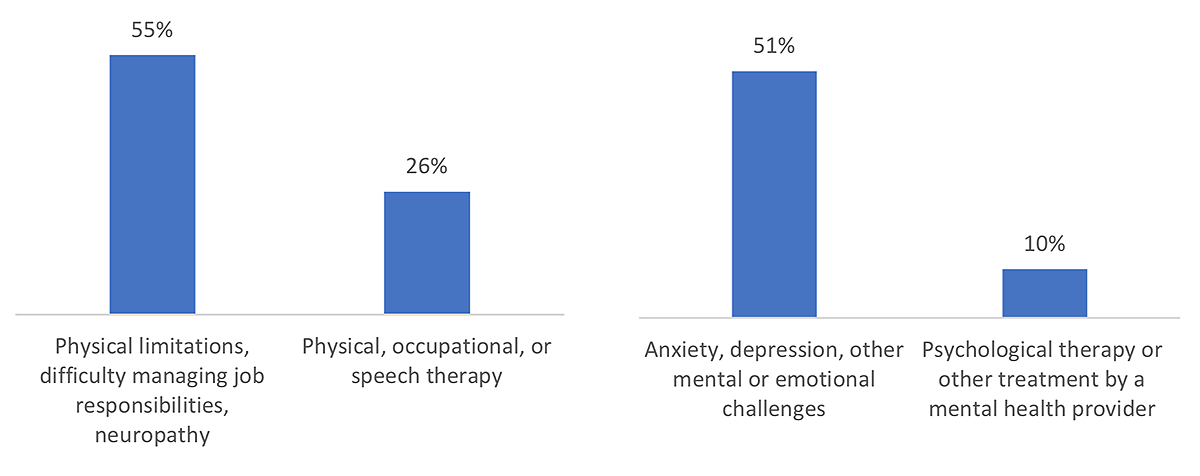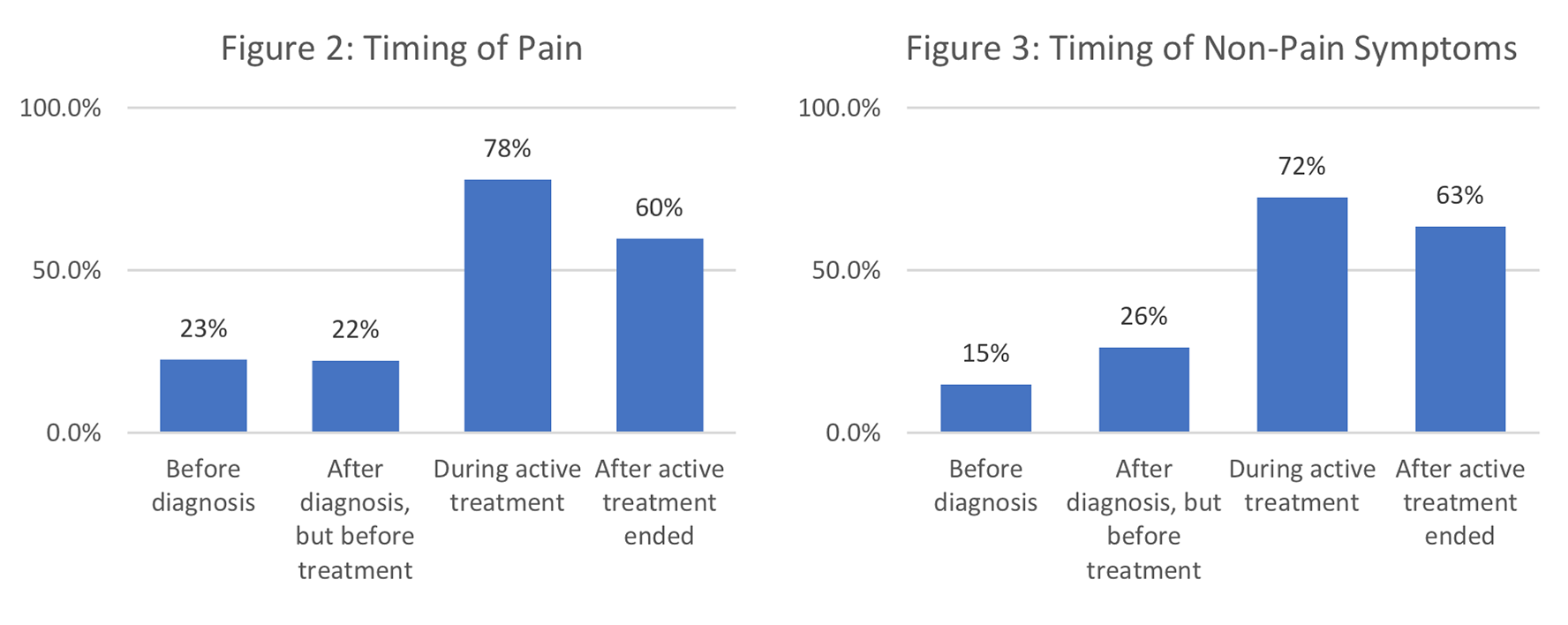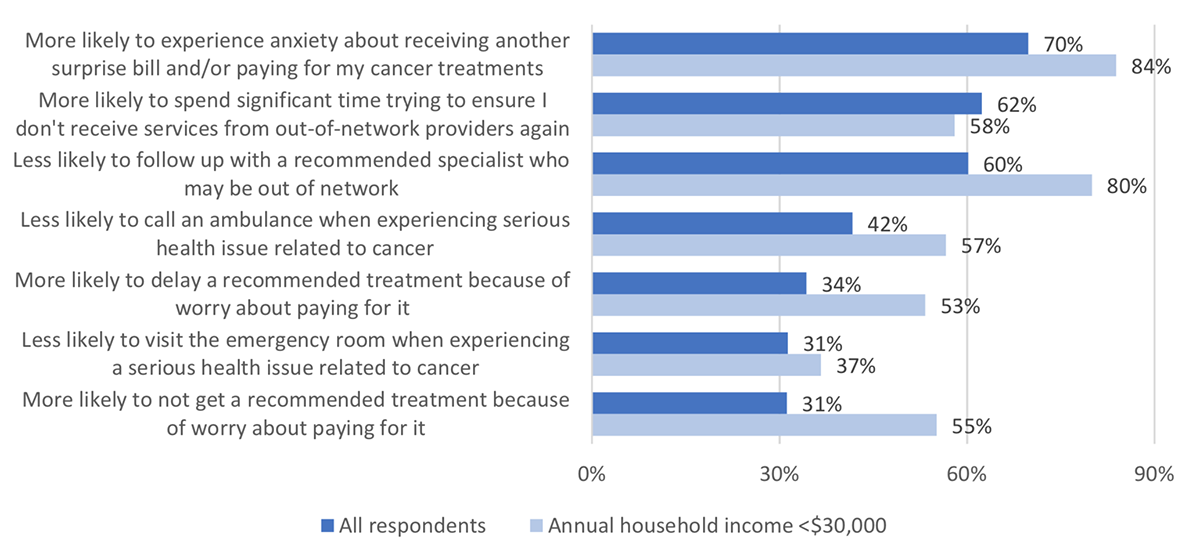Overview:
Survivor Views is a new and unique initiative being executed by the American Cancer Society Cancer Action Network (ACS CAN) in January 2019. The project has established a cohort of 3,055 cancer patients and survivors diagnosed with and/or treated for cancer within the last five years who are willing to share their opinions and experiences through a series of surveys focused on policy issues impacting cancer patients and survivors.
In August and September 2019, Survivor Views conducted its first survey to the cohort focused on their experiences with cancer symptoms and side effects, including pain, and the availability and use of palliative or supportive services to treat these. The web-based survey was sent to 2,360 Survivor Views cohort members, 1,111 of whom responded to the survey (a 47% response rate). This sample provides a margin of error +/- 3% and 95% confidence level.
The research provides important insights into the experiences of cancer patients and survivors in managing cancer symptoms and side effects.
Key Findings:
Key findings from the pain and palliative care survey include:
- Cancer patients and survivors report a wide range of physical and emotional side effects, including pain, loss of energy, anxiety and depression, and limitations of physical function, among others. However, far fewer survivors are being offered treatments that would address those symptoms, indicating a significant opportunity to improve function and quality of life for cancer survivors.
- The physical and mental symptoms and side effects of cancer don’t end when active treatment is over. Two-thirds of respondents who reported symptoms and side effects told us they continued to experience these issues after the end of active treatment. For many survivors, these symptoms persisted for more than a year after they finished their active treatments.
- Cancer patients and survivors who are currently taking or were recently prescribed opioids as part of their cancer treatment have encountered several barriers to obtaining these medications; including at the pharmacy, at the doctor’s office, and with insurance coverage. These barriers have resulted in a range of negative implications, including inability to participate in work, family, or social events; additional visits required to doctors or pharmacies to receive the treatment; visits to the Emergency Department to treat pain and other symptoms and side effects; and setbacks in the treatment of their cancer.
The next Survivor Views survey, covering topics related to accessibility of care for cancer survivors, is currently in the field through early November 2019.
Survey Findings
The Survivor Views Pain and Palliative Care survey asked cancer patients and survivors to indicate which symptoms and side effects they had experienced as a result of their cancer and its treatment. The symptoms most commonly reported include loss of energy (55%), anxiety (44%), memory loss (43%), and neuropathy (38%).1 While some symptoms are more commonly experienced among those whose cancer is diagnosed at a more advanced stage, others (including anxiety and depression) are reported regardless of stage.
These symptoms and side effects impact nearly all cancer patients and survivors, with 45% of respondents indicating they experienced four or more negative symptoms or side effects. Though many of these symptoms may be alleviated by treatments and supportive services, patients’ accessing these interventions substantially lags behind the incidence of symptoms (Figure 1).
Figure 1: Respondents experiencing symptoms compared to use of treatments

Survey responses indicate that cancer patients and survivors may experience symptoms throughout the duration of their cancer experience, including after the end of active treatment. Sixty percent of patients and survivors who reported pain told us that their pain continued after the end of active treatment and 63% of those experiencing non-pain symptoms continued to have those symptoms after active treatment (Figure 2 and Figure 3). This finding emphasizes the importance of continued treatment and supportive services as patients transition from active treatment to cancer survivorship.

Fifty-one percent of cancer survivors participating in the survey indicate that they had been prescribed an opioid medication as part of their cancer treatment, and 19% had been prescribed an opioid within the last 12 months. Of these, nearly half (41%) report experiencing one or more challenges when obtaining and/or filling their opioid prescription. Those challenges have had real impact on their health and lives, with 29% of respondents who encountered barriers telling us this situation made them unable to participate in work, family, or social events, 27% had to return to the doctor and 26% had to make additional trips to the pharmacy to adjust or obtain their prescription. 12% felt their treatment was impacted by insufficient pain control resulting from the difficulty accessing medication, and 12% reported requiring a trip to the Emergency Room due to uncontrolled pain (Figure 4).
Figure 4: Reported impact of challenges obtaining opioid pain medication

Among those who have recently or are currently taking opioids, over half report some degree of concern about their future ability to access opioid medication based on their personal experiences, those of family and friends, or media coverage of the opioid crisis.
Methodology
Survivor Views is an ACS CAN initiative designed to enhance the organization’s mission to end suffering and death from cancer. Data provided by cancer patients and survivors as part of this project allows for a greater understanding of their experiences and opinions on cancer-related issues and gives voice to cancer patients and survivors in the shaping and advocating of public policies that help prevent, detect, and treat cancer and promote a more positive quality of life for those impacted.
To ensure the protection of cohort participants as we pursue these objectives, all research protocols, questionnaires, and communications undergo review by the Morehouse School of Medicine Institutional Review Board.
The Survivor Views cohort is comprised of individuals who meet the following criteria:
- Diagnosed with and/or treated for cancer within the last five years
- Over the age of 18
- Reside in the US or US territories
The Pain and Palliative Care survey was conducted using a web-based survey sent to 2,360 Survivor Views cohort members. The data were collected between August 20 and September 9, 2019. A total of 1,111 participants responded to the survey, a 47% response rate. This sample provides a margin of error +/- 3% and 95% confidence level.
About ACS CAN
The American Cancer Society Cancer Action Network (ACS CAN) is making cancer a top priority for public officials and candidates at the federal, state and local levels. ACS CAN empowers advocates across the country to make their voices heard and influence evidence-based public policy change as well as legislative and regulatory solutions that will reduce the cancer burden. As the American Cancer Society’s nonprofit, nonpartisan advocacy affiliate, ACS CAN is critical to the fight for a world without cancer. For more information, visit www.fightcancer.org.
1 Neuropathy is nerve damage that can cause tingling, burning sensation, weakness, pain and numbness. For more information, visit https://www.cancer.org/treatment/treatments-and-side-effects/physical-si...


